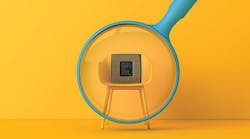Retrofitting Pharmaceutical Processes with WirelessHART Instrumentation
Pharmaceutical companies are under the same pressures as many other industries to improve operations, produce associated documentation, ensure quality products, reduce maintenance and other operating costs, and maintain a safe facility. One way to accomplish these objectives is via an Industrial Internet of Things (IIoT) strategy using a digital ecosystem to monitor processes and assets, analyze the data, and take steps to improve and optimize equipment operation and processes.
When executing this type of strategy, two issues must be considered. The first is that most manufacturing facilities are dependent upon wired instrumentation, and it often becomes cost-prohibitive to extend monitoring and optimization capabilities beyond the fundamental operations. Oftentimes there is limited spare I/O capacity, and no ability to leverage the existing wired infrastructure. Adding more wired instrumentation to an existing infrastructure is not only expensive, but also introduces additional challenges with cleanliness. The second issue is the need for hygienic cleanliness throughout the process. Any added instrumentation must be compatible with the cleanliness requirements.
In this article, we’ll examine how WirelessHART instrumentation can be used to cost-effectively and hygienically collect more data from the process and equipment to improve operations.
BASICS OF WIRELESSHART
WirelessHART is an open standard supported by hundreds of companies through the independent FieldComm Group. A WirelessHART installation typically includes:
- One or more WirelessHART instruments
- A gateway to receive wireless signals from up to 100 instruments
- A wired connection — such as Ethernet or Modbus — for the gateway to send data to a host system
- Analytical software to turn the data into actionable information.
No wiring, cables, conduit or power supplies are needed because each WirelessHART instrument contains a power module. The WirelessHART system can operate completely independent of the plant’s control system — for example, with a connection to an asset management or data analytic system. The control system can also have access to the data, if so desired.
When multiple wireless instruments are involved, they form a mesh network (Figure 1), where signals from one instrument are relayed by other instruments until they reach the gateway. This allows the WirelessHART signals to bypass obstacles, cover greater distances, and provide network redundancy if one instrument fails. The mesh network also makes it possible to monitor mobile equipment.
A WirelessHART infrastructure includes wireless instruments that form a mesh network and connect to a gateway. Data from the gateway is then sent to one or more host systems.
MOBILE MONITORING
Some pharmaceutical facilities make use of portable and mobile equipment, such as process skids and tanks moving ingredients and materials from one part of the process to another, often to different floors. In many cases, ingredients or materials must be monitored while being moved or stored. This is particularly important for items that must be maintained within a certain temperature range.
Wireless instruments installed on mobile skids and tanks let them be moved throughout a five-story building, such as this pharmaceutical facility, allowing the control system to continuously monitor temperatures.
Monitoring temperature of a mobile or portable skid or tank is very difficult with wired instrumentation, but it is a simple matter for WirelessHART, even if the mobile equipment is being moved through several different areas or floors of a building (Figure 2). With wireless, if a portable process tank is moved to a refrigerated area, the temperature in the tank can still be monitored to ensure there are no excursions.For example, one life sciences company had mobile process skids that were frequently moved, and needed reconfiguration at each new location because they lost contact with the control system while being relocated. The company installed a single WirelessHART network in the five-floor process building and installed wireless instruments on each skid.
Because the wireless instruments maintained contact with the control system while being moved from floor to floor, reconfiguration to accept signals from the process skids’ wired instruments at the new location was eliminated. Installation and startup of the wireless system was completed in less than eight hours, and the network has demonstrated excellent reliability in the five-story building, even with its 12-inch-thick reinforced concrete floors.
CLEANABILITY
As noted previously, wireless instruments require no power or signal cabling. Wired instruments, on the other hand, require cable, conduit and cable trays that must be periodically washed down when installed in hygienic environments.
Wireless pressure, temperature and humidity instruments can be installed in a clean room, eliminating the need for a technician to periodically make manual measurements and perform data entry.
Cleanability is especially critical in clean rooms (Figure 3). WirelessHART instrumentation for measuring temperature, pressure and humidity eliminates the need for making wall penetrations, which could require recertification of the clean room. Clean rooms may also require recertification if a door is left open too long. A wireless device can easily be installed to monitor whether a clean room door is open or closed.For example, a clean room lab in Singapore had to manually monitor temperature and humidity every two hours, and then enter the data into a log by hand. This disrupted operation because it required a technician to take the measurements and perform the data entry. As part of an upgrade to automate and modernize the lab, the company installed wireless instruments and software to make the measurements and log the data, and eliminated the need for technicians to enter the lab just to record these measurements.
MONITORING EQUIPMENT
WirelessHART monitoring systems can be retrofitted on plant equipment such as steam traps, pumps, pressure relief valves and similar devices. Key areas include refrigeration units and their support systems to detect a pending failure so corrective action can protect the final product.
Take steam traps, for example. A wireless monitoring system requires acoustic steam trap monitors, a gateway and analytical software.
Acoustic steam trap monitors clamp onto the steam line, so there is no need to shut down the process during installation. Once installed, a technician enters Join Key information via the wireless system software, and the monitor automatically joins the wireless network and starts transmitting information to the gateway. Installation takes only a few minutes, depending mostly on how difficult it is to access the mounting location.
The acoustic monitor “listens” to the steam line and transmits data to the gateway. Information from the gateway can be sent to the plant’s control and monitoring system for analysis, or it can be sent to a PC that’s equipped with steam trap monitoring software. The software analyzes the incoming data to detect a steam trap that has failed open or closed or is leaking, and notifies the maintenance department.
The automated monitoring system eliminates the need to send technicians into the plant to inspect steam traps on a periodic basis, thus cutting costs and improving worker safety. When a problem does occur, the software identifies the specific trap and informs the technician of the specific problem.
When web-based steam trap analytical software “apps” are used, the data can be viewed on any Internet-connected device capable of hosting a browser such as a laptop, a smartphone or a tablet.
Such a system does not require connection to the plant’s control system, historian, database, ERP or CMMS system, nor does it require a significant investment in computing power, software and consulting. Instead, a dedicated WirelessHART monitoring system for steam traps can be purchased for a fraction of the cost of a traditional system, and plant personnel can install it themselves. And once the first WirelessHART system is installed with its gateway and mesh network, additional dedicated equipment monitoring systems can be installed at an even lower cost because they will simply join the existing network.
RETROFITTING PROCESSES
WirelessHART instruments can also be retrofitted on existing processes to provide control systems with additional parameters. Because the instruments provide a HART-compatible signal, the gateway can make the information available to any legacy control system using standard HART data protocols.
One perceived problem with wireless transmission has always been, “It’s too slow, so we can only use wireless for monitoring purposes. We can’t use wireless for control.” This may have been true in the past, but recent developments are making it possible to use wireless for control.
Many monitoring and control applications do not require fast scan rates. By applying the technology correctly and setting update rates to meet the needs of the application, additional insight can be gained. A key application is using the Rosemount 648 wireless temperature sensor with X-Well technology. For the first time, a highly accurate process temperature can be achieved without the need for a thermowell or intrusion. The instrument clamps on and uses measurements of the pipe surface temperature, ambient temperature and thermodynamic properties to create precise process temperature measurements.
ANYTHING, ANYWHERE
Wireless is often the best way to retrofit and modernize an existing pharmaceutical manufacturing plant’s instrumentation system. Wireless instruments and a wireless infrastructure are cost-effective to install and don’t introduce issues with cleanliness, like additional wires or penetrations in a clean room. Such a system can be used to monitor “anything, anywhere,” because the instruments require no wiring, cable, conduit or electrical power, and can therefore be installed on any piece of equipment, fixed or mobile.
Recent developments in hardware and analytical software have made it possible to employ wireless equipment monitoring systems for a fraction of the cost of a wired solution, bringing the benefits of automation to production processes as well as supporting utilities.
Michalle Adkins is the director of life sciences consulting at Emerson Automation Solutions. Michalle has more than 25 years of pharmaceutical industry related experience, including 13 years with Merck. Dan Carlson is solution architect at Emerson Automation Solutions. He has been with Emerson for 15 years, working on wireless technology and applications.









